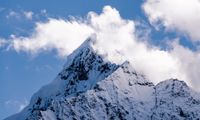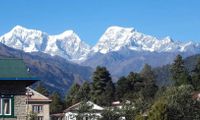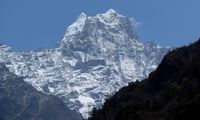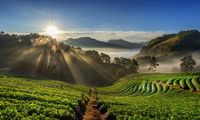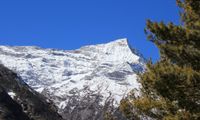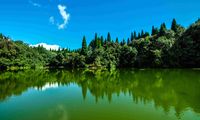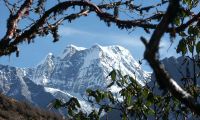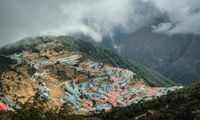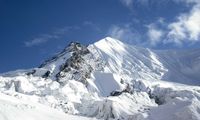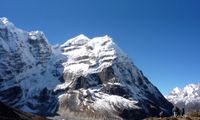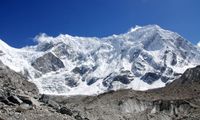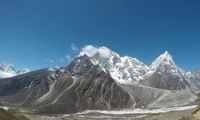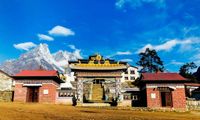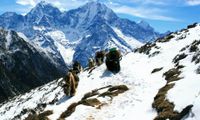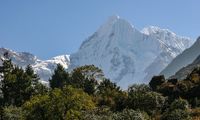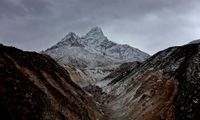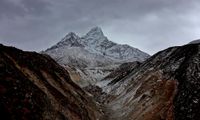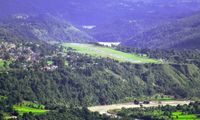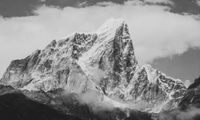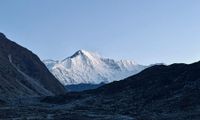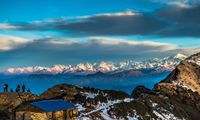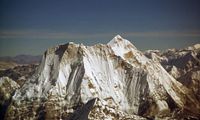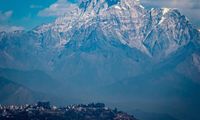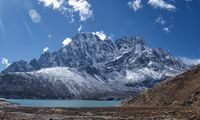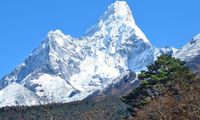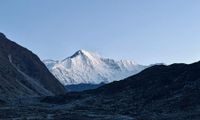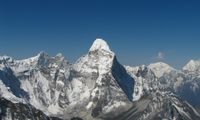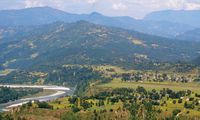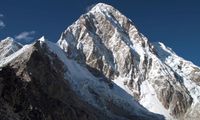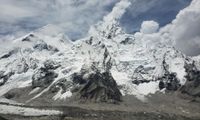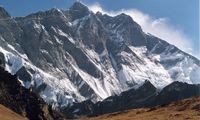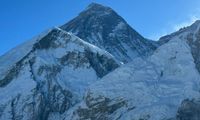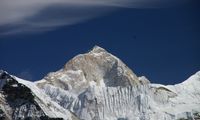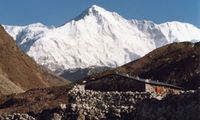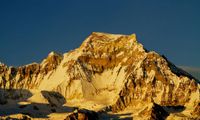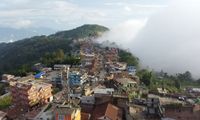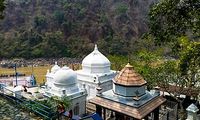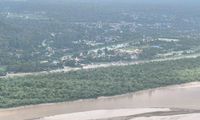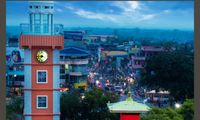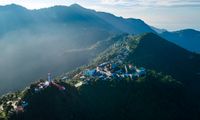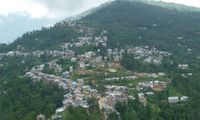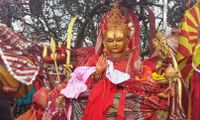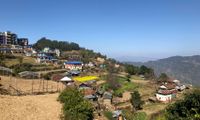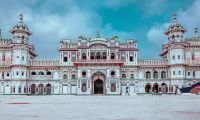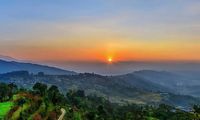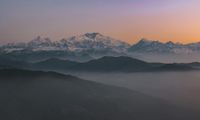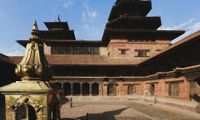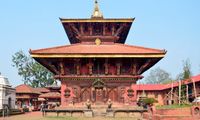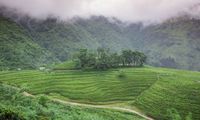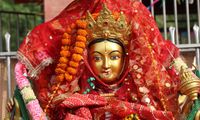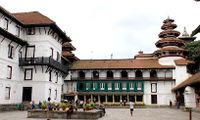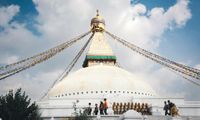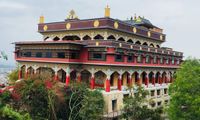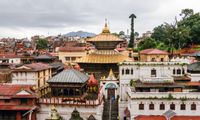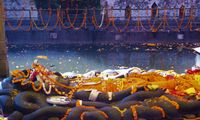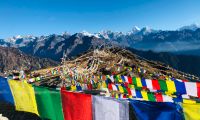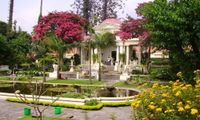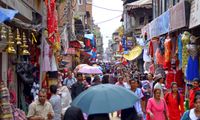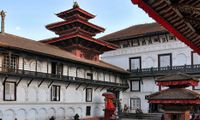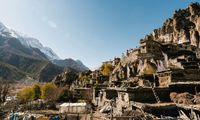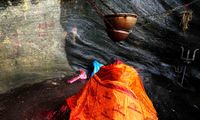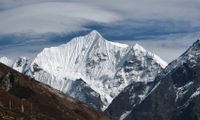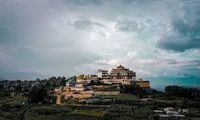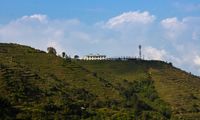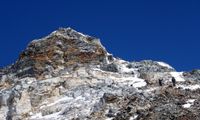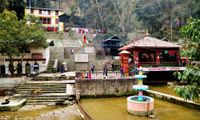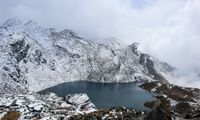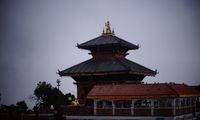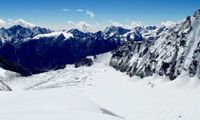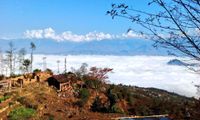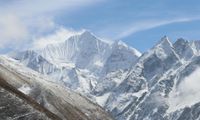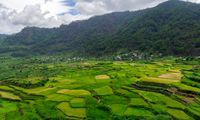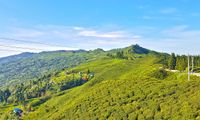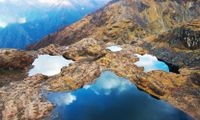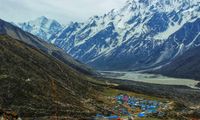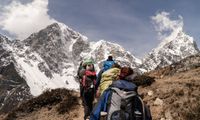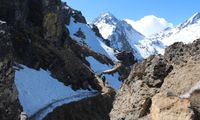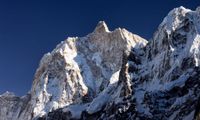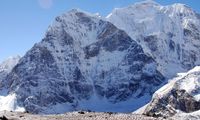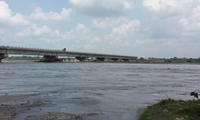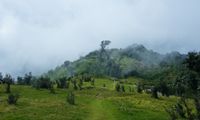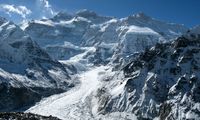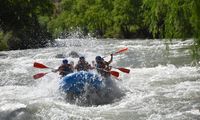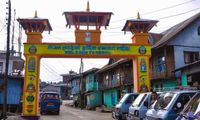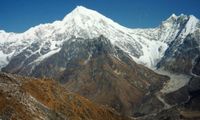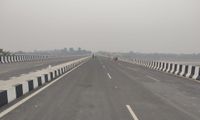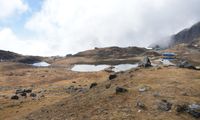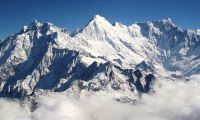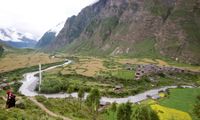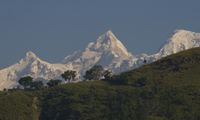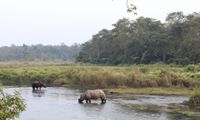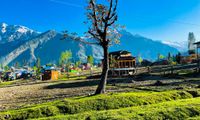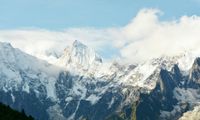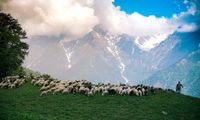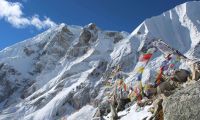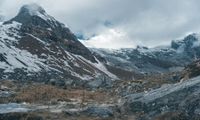Pattale Village
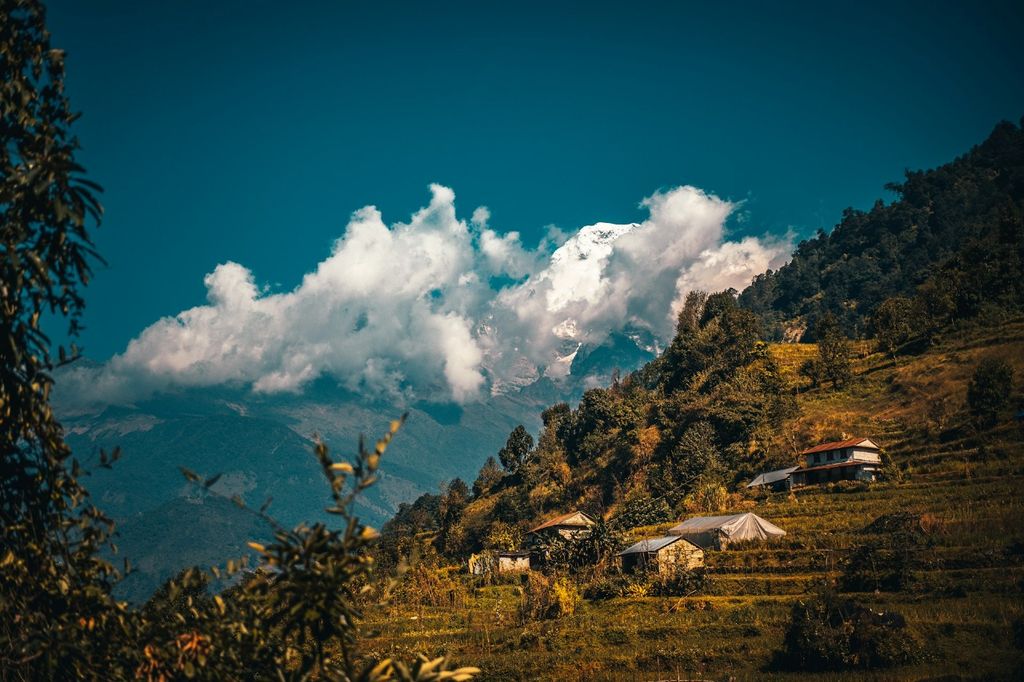
About
Situated in Okhaldhunga District, Patle Village is home predominantly to Magar and Rai communities, who have lived there for generations. With terraced fields, traditional wooden houses, and spectacular panoramas of eastern Himalayan giants like Everest, Kanchenjunga, and Makalu, the village encapsulates rural beauty and cultural endurance. The climate is temperate, with crisp mountain air and seasonal biodiversity—rhododendron forests in spring, golden terraces in autumn.
Locate Us
Nearby Attractions
Nestled in the lush foothills of eastern Nepal, Pattale Village offers an authentic trekking experience removed from crowds. At an altitude of around 2,700 m, this off‑the‑beaten‑path destination blends sweeping Himalayan views, vibrant ethnic traditions, and warm homestay hospitality. Ideal for travelers seeking cultural immersion rather than adrenaline-fueled peaks, Pattale Village delivers meaningful connections with nature and community.
Overview
The Pattale Village trek offers a moderate and rewarding journey through Nepal’s mid-hill terrain, making it an excellent choice for cultural explorers and nature lovers alike. Unlike high-altitude expeditions, this trek focuses on immersion rather than elevation, with daily distances ranging between 6 to 10 kilometers. The total elevation gain is approximately 700 to 900 meters, depending on your chosen trailhead and pace.
While Pattale doesn’t have formal trekking infrastructure, the region is crisscrossed by well-worn footpaths maintained by local villagers. These trails pass through terraced farms, forests of oak and rhododendron, and stone-paved village paths. The terrain is varied but not technically challenging, making it accessible to trekkers with a reasonable level of fitness. Most days involve 4–6 hours of hiking, with gradual ascents and descents that are manageable for beginners and experienced hikers alike.
What truly sets this trek apart is its emphasis on community connection and natural beauty. You’ll walk alongside locals carrying baskets of harvested millet, rest in cozy family-run homestays, and enjoy sweeping views of eastern Himalayan giants like Kanchenjunga and Makalu. For those seeking a quieter, more culturally meaningful trek in Nepal—free from commercial crowds—the Pattale Village trail is a hidden gem worth discovering.
Why Visit Pattale Village?
- Authentic Local Connection: Stay with villagers, participate in daily agricultural life, and enjoy traditional meals.
- Serene Views & Solitude: Panoramas of Himalayan peaks with few tourists.
- Cultural Discovery: Explore ethnic music, dance, and festive traditions still active in daily life.
- Year-Round Trekking: Seasons bring distinct experiences—from wildflowers in spring to vibrant harvest season in autumn.
- Panoramic Vistas: Mount Kanchenjunga dominates the skyline, with distant peaks of Everest, Makalu, and Lhotse appearing on clear days.
- Village Charm: Traditional wooden homes decorated with prayer flags, locally carved mani stones, and community spaces.
- Festivals & Rituals: Traditional musical gatherings, seasonal feasts, and local rituals—for example, Lama-led blessings during Dashain.
How to Get to Pattale Village
- From Kathmandu: Drive (~8–10 hrs) to Okhaldhunga Bazaar, then a scenic two-hour jeep/jeep‑ride to Taplejung Road, followed by a 3–5 km hike into Pattale.
- Via Okhaldhunga: Regular local buses and micro‑vans run daily. Roads vary with the season—muddy and slow during monsoon, crisp and dusty in autumn. Hiring a jeep from Okhaldhunga is more comfortable, though walking nets richer local engagement.
- Local Trailheads: Trekkers may start from Bhandar or Phaktanglung, combining community trails and ridge paths to reach Pattale Village.
Best Time to Visit Pattale Village – Monthly Weather Insights
Choosing the right time to visit Pattale Village is key for a fulfilling and safe trekking experience. Located in the mid-hill region of Okhaldhunga District and situated around 2,700 meters above sea level, Pattale Village offers varying landscapes throughout the year. From lush rhododendron forests in spring to golden terraced fields in autumn, the village offers unique seasonal charm.
Here’s a detailed month-by-month guide to help you plan your journey to Pattale Village:
1. Spring (March to May)
- The most ideal time for trekking and nature exploration.
- Rhododendrons bloom across the hills, filling the trails with vibrant colors and sweet fragrances.
- Clear skies dominate this season, offering perfect views of Mount Kanchenjunga, Makalu, and the surrounding Solu peaks.
- Temperatures range from 10°C to 20°C, making trekking comfortable and enjoyable.
- This season is also great for birdwatching and observing local flora.
- Villages around Pattale are bustling with agricultural preparation, adding a lively cultural dynamic.
- Considered the peak season for visiting Pattale Village due to favorable weather and natural beauty.
2. Summer / Monsoon (June to August)
- Not recommended for trekking unless you're focused on village-based cultural experiences.
- Heavy rainfall leads to muddy, slippery trails and occasional landslides, particularly on jeep-access roads.
- Dense cloud cover can block mountain views, and leeches are common in forested areas.
- However, the landscape becomes incredibly green, making it visually stunning for photography or slow village stays.
- If visiting during this period, stick to the lower trails and consider hiring a local guide for safety.
3. Autumn (September to November)
- The most popular season to visit Pattale Village due to crystal-clear skies and stable weather.
- Post-monsoon freshness brings breathtaking views of the Himalayas, ideal for sunrise and sunset hikes.
- Daytime temperatures hover between 10°C and 18°C, while nights are cool and comfortable.
- Local festivals like Dashain and Tihar fall during this time, adding deep cultural value to your trek.
- The fields turn golden with ripe crops, making this the most photogenic season for rural Nepal.
4. Winter (December to February)
- Perfect for travelers who enjoy solitude and colder climates.
- Pattale Village transforms into a peaceful highland with frosty mornings and crisp skies.
- While trekking is still possible, temperatures can fall below 0°C at night, so proper winter gear is essential.
- Homestay availability may be limited, and you'll need to rely on basic amenities and camping options for high ridgeline explorations.
- Snowfall is rare in the village itself but may occur at nearby higher viewpoints.
Final Weather Tips for Pattale Village Trekkers:
- Check local weather forecasts before heading out, especially in monsoon and winter months.
- Avoid trekking during the monsoon unless you're focusing on village cultural experiences, not viewpoints.
- Always carry layered clothing, including a windproof jacket, as temperatures can shift dramatically between day and night.
- Ideal visit duration: 4–5 days to explore the village, enjoy short day hikes, engage with locals, and capture the full scenic value.
Height and Altitude of Pattale Village
Pattale Village sits gracefully at an altitude of approximately 2,700 meters (8,858 feet) above sea level, nestled within the mid-hill region of Okhaldhunga District in eastern Nepal. This elevation places it above the subtropical belt yet comfortably below high-altitude trekking zones, creating an ideal environment for moderate treks rich in both culture and natural beauty.
The altitude of Pattale Village offers a balanced trekking experience—high enough to provide expansive Himalayan views, yet low enough to minimize the risk of altitude sickness. On clear days, trekkers can enjoy panoramic vistas of towering eastern Himalayan peaks, including Kanchenjunga, Makalu, and even distant glimpses of Everest, all without the need for specialized acclimatization.
Unlike strenuous high-altitude expeditions, the trails leading to and from Pattale are accessible to most moderately fit travelers. The region’s elevation also supports a biodiverse ecosystem—lush rhododendron forests in spring, terraced fields during harvest season, and crisp mountain air year-round.
Whether you're drawn by the sweeping views, the cultural encounters, or the serene trails, the elevation of Pattale Village offers a rewarding and immersive Himalayan experience, perfect for those seeking depth over altitude in their Nepal trekking adventure.
Where to Stay in Pattale
Local homestays are the cornerstone of accommodation—family-run, simple but clean. Expect dorm-style or private rooms, earthen or plank floors, and shared bathroom facilities. No formal teahouses exist here, so the meal is cooked by your host family. Electricity is limited (mostly solar-powered, evening lighting), and hot showers are uncommon. Booking ahead through local trekking operators or host contacts ensures availability, especially in peak seasons.
Food and Water Availability
Meals are based on local produce—dal‑bhat, vegetable curry, gundruk (fermented greens), and local teas (ginger or lemon). Vegetarian options are plentiful. Bring purification tablets or a filter; water is typically drawn from mountain springs or community taps—clean but not always boiling hot. Avoid tap water unless treated. Hosts offer refillable bottles for trekkers.
Permits and Entry Requirements
You may need a local municipal permit from the Okhaldhunga rural municipality office (~ Rs. 200–300). TIMS permits are not required unless you’re heading into national parks. Check with local tourism offices for any seasonal restrictions or community-based tourism contributions (~Rs 500–800, often optional but appreciated).
Things to Do in Pattale Village
- Cultural Walks: Roam through terraced fields, visit traditional homes, witness daily chores like millet harvesting or goat herding.
- Local Workshops: Observe weaving, local bread baking, or seasonal festivals like Maghe Sankranti and Udhauli-Ujauli.
- Photography: Sunrise over Kanchenjunga, misty mountain ridges at dusk, children playing in courtyard fields—ideal for candid storytelling.
- Short Viewpoint Hikes: Local guides can take you to nearby ridges at 2,800–3,200 m for panoramic views on quiet trails.
Local Culture and People
The local population comprises Magar and Rai ethnic communities, each with unique traditions. The Magars are known for ethnic song and dance (halka, Sorathi) while the Rai practice shamanic rituals and celebrate festivals like Mela Rai, Sakela, and Fagu. Most households speak Nepali along with their local language. Hospitality is genuine—you may be invited to share yak-cheese tea or help harvest millet.
Festivals Celebrated in Pattale
- Maghe Sankranti (mid‑January) – ritual bathing, communal feasts.
- Dashain & Tihar (autumn and late autumn): Houses blessed, local shrines visited.
- Sakela and Udhauli/Ujauli – community dances and seasonal rituals in celebration of nature’s cycles.
Flora and Fauna
Expect flowering rhododendron groves in spring, oak and hemlock trees, and seasonal flowers like primulas and orchids. Birdlife includes monal, Himalayan bulbul, and woodpeckers. While large mammals are rare on tracks, small deer, porcupines, and tribal honey gatherers’ bees may be spotted in early morning hikes.
Trek Difficulty & Altitude Insights
Trails are simple footpaths through farmland and forest sediment, with moderate grading. Daily altitudes rise by about 400–500 m, and the highest viewpoints approach 3,200 m. Altitude sickness is rare if you ascend slowly and acclimatize. Basic stamina and good donning shoes are enough; trekking poles are helpful on slopes and loose footing.
Packing List for Pattale Village Trek
- Clothing: Layered clothing—base layers, warm mid-layers, wind‑resistant outerwear; lightweight trousers or hiking pants.
- Footwear: Waterproof boots or trail shoes, gaiters, light sandals for village wear.
- Gear: Daypack, trekking poles, sunhat, UV sunglasses, headlamp.
- Toiletries & Safety: Basic First-aid, personal meds, water filter/tablets, reusable water bottle, power bank.
- Extras: Power adapter Nepal type, small towel, biodegradable soap, local currency in small notes.
Travel Tips for Trekkers
- Mobile Coverage: Ncell signal may reach Pattale Village; NTC often drops out. A local SIM recharge ensures communication.
- Cash & ATMs: Carry enough cash; nearest ATM in Okhaldhunga Bazaar.
- Guides: Hiring local guides supports the community and ensures safe passage. They know hidden viewpoints and host families.
- Cultural Respect: Ask permission before photographing villagers, avoid photographing ritual sites when asked, remove shoes before entering homes.
- Health & Safety: Be cautious of altitude: stay hydrated, rest before ascending; treat water before drinking.
Nearby Attractions
- Ridgelines above Pattale: Follow villager trails to hidden vantage points with 360° views.
- Phaktanglung National Park: Beginning trailheads may intersect this park boundary—explore regional biodiversity if you extend the trek.
- Local Villages: Community trails to neighbouring hamlets like Cheram, Lumshi, or Dumre, each offering distinct ethnic encounters.
Related Treks Starting from Pattale Village:
If the charm of Pattale Village and its serene Himalayan foothills captivate your spirit, consider extending your adventure with these lesser-known but equally enchanting treks in the Okhaldhunga and eastern Nepal region. Perfect for trekkers seeking authentic cultural encounters, panoramic mountain vistas, and peaceful trails far from the bustle of popular trekking hubs, these routes offer diverse experiences blending nature, tradition, and tranquility.
- Pattale to Pikey Peak Trek (5–6 Days):
This moderately challenging trek takes you from Pattale Village towards the iconic Pikey Peak, rising to approximately 4,065 meters. Along the way, you’ll pass through charming villages, terraced farmland, and pristine forests of rhododendron and oak. The summit offers breathtaking 360-degree views encompassing Mount Everest, Kanchenjunga, and Makalu. This trek combines rewarding panoramic vistas with intimate community stays, making it ideal for trekkers eager to connect with local Rai and Magar cultures while enjoying stunning Himalayan landscapes. The trail is well-suited for moderate fitness levels and offers a balance of hiking and cultural immersion.
- Pattale Village Loop through Solukhumbu Villages (6–7 Days):
For those interested in multi-ethnic cultural exploration alongside moderate trekking, this loop trail links Pattale with several traditional Solukhumbu villages such as Cheram, Lumshi, and Dumre. Each village reflects unique Rai and Sherpa heritage, festivals, and artisan crafts. The trail meanders through forested ridges, terraced fields, and mountain streams, offering peaceful hiking conditions with manageable ascents. Along the way, trekkers can experience local festivals, taste home-cooked meals, and engage with villagers’ daily lives. This loop is ideal for travelers who want a rich cultural tapestry woven with scenic beauty away from crowded routes.
- Pattale to Dudh Kund Glacial Lakes Trek (4–5 Days):
For adventure seekers interested in natural wonders and alpine scenery, the trek from Pattale to the Dudh Kund glacial lakes provides a spectacular experience. The trail climbs gradually through dense forests and open ridges, passing small settlements and yak pastures. The glacial lakes, nestled at higher altitudes, reflect surrounding snow-capped peaks and pristine skies, creating breathtaking photo opportunities. This trek offers a mix of moderate physical challenge and serene natural beauty, with fewer trekkers and a genuine off-the-beaten-path atmosphere. It’s perfect for nature lovers, photographers, and trekkers seeking solitude in the Himalayas.
Each of these treks starting from Pattale Village offers a unique blend of cultural richness, moderate trekking challenges, and stunning mountain scenery. Whether you’re drawn to the panoramic summit views of Pikey Peak, the cultural immersion of Solukhumbu village loops, or the alpine serenity of Dudh Kund lakes, these routes provide rewarding alternatives to Nepal’s more frequented trails. Adding one or more of these treks to your itinerary promises deeper connection with eastern Nepal’s diverse communities and landscapes—perfect for travelers craving authentic, meaningful Himalayan journeys.
How Pattale Village Compares to Other Treks in Nepal
When choosing a trekking destination in Nepal, it’s essential to consider what kind of experience you’re seeking. Pattale Village offers a unique blend of cultural authenticity, moderate trekking challenges, and peaceful natural beauty that sets it apart from the more commercialized and high-altitude routes like Everest or Annapurna.
Unlike the popular Everest and Annapurna regions, which are known for their dramatic high-altitude climbs, well-developed infrastructure, and bustling teahouse trails, Pattale Village offers a quieter, more intimate trekking experience. It’s ideal for travelers who want to immerse themselves in local life, enjoy moderate terrain, and avoid the crowds.
Distinctive Features of Everest and Annapurna Treks:
- High-altitude routes reaching above 5,000 meters, including iconic peaks and challenging passes
- Extensive trekking infrastructure with numerous teahouses, lodges, and trekking agencies
- Reliable access to electricity, Wi-Fi, and tourist services in most villages
- Heavy tourist traffic, especially in peak seasons, leading to busy trails and social trekking atmospheres
- Guided group tours and organized trekking packages are widely available
- Suitable for experienced trekkers and those seeking iconic Himalayan mountaineering adventures
Unique Qualities of Pattale Village Trekking:
- Moderate altitudes, with highest viewpoints around 3,200 meters, making altitude sickness rare
- Simple footpaths through farmland, forests, and traditional villages rather than crowded trekking highways
- Homestay accommodations run by local families, offering authentic cultural exchange over commercial lodges
- Limited infrastructure—solar power, basic facilities, and no Wi-Fi—enhancing the sense of remoteness and tranquility
- Low tourist numbers, allowing for solitude and more personal interaction with Rai and Magar communities
- Emphasis on community-based tourism and sustainable travel, supporting local development and preserving traditions
- Perfect for beginners, cultural explorers, and nature lovers seeking meaningful connections without the strain of high-altitude trekking
Your choice between popular trekking regions like Everest or Annapurna and the Pattale Village trail ultimately depends on your priorities. If you desire iconic Himalayan summits, bustling teahouse trails, and well-supported trekking logistics, the established regions will fulfill those expectations. These areas offer stunning high-mountain landscapes but come with heavy foot traffic and a more commercial feel.
Pattale Village, in contrast, provides a serene, less-explored alternative that invites trekkers to slow down, savor rural Himalayan life, and enjoy panoramic mountain views without the rigors of extreme altitude. The trail’s moderate grading and cultural immersion opportunities make it especially attractive for travelers who want to experience Nepal’s rich ethnic diversity alongside scenic beauty.
In short, Pattale Village is a perfect destination for those looking to escape mainstream trekking circuits while still experiencing the magic of the Himalayas. It’s a quiet, rewarding journey that emphasizes depth over distance, people over peaks, and authenticity over amenities.
Common Challenges for Trekkers
- Inconsistent trail markers—ask locals for directional tips.
- Seasonal road disruption—monsoon may wash roads near Okhaldhunga; try jeep transport.
- Limited winter lodging—cold nights and reduced homestay availability Dec–Feb.
- Communication gaps—a few basic Nepali phrases help smoothly negotiate local services and respect customs.
Photo Opportunities in Pattale
- Early morning courtyard capturing sunlight on prayer‑flag adorned homes.
- Village ridgeline at dusk with Kanchenjunga framed in pastel skies.
- Harvest season festival during Maghe Sankranti—colorful cultural tableau.
Tips for Solo Travelers in Pattale Village
- Pattale Village is safe and welcoming, with locals friendly to visitors.
- Always stay with official homestays to ensure a reliable and comfortable experience.
- Inform the rural municipality office of your visit for added safety and support.
- Consider hiring a local guide for hiking assistance and language translation.
- Take your time to walk at a slower pace to fully enjoy conversations and cultural immersion.
- Carry a local SIM card or ensure mobile connectivity via Ncell for emergencies.
- Respect local customs: ask permission before taking photos and remove shoes before entering homes.
- Keep emergency contact information and basic first aid supplies handy.
- Trust your instincts and avoid walking alone in isolated areas after dark.
- Carry sufficient cash, as there are no ATMs or Wi-Fi in the village.
Local Initiatives and Development
Pattale Village supports community-managed tourism, with part of homestay fees reinvested into trail upkeep and school programs. Women-led initiatives include weaving cooperatives and traditional crafts sold via host families. Trekkers are encouraged to purchase local handicrafts—which keeps money local.
Conclusion
Pattale Village is a quietly powerful destination: moderate terrain, jaw‑dropping Himalayan views, and real cultural exchange. Far from the commercialization of Everest or Annapurna, it offers serenity, authenticity, and the chance to walk in the footsteps of generations of villagers. For trekkers seeking depth over altitude, vivid tradition over crowds, and community over lodges, Pattale Village is waiting. Put it on your itinerary — you won’t regret it.
FAQs
Q: Do I need TIMS or ACAP permits for Pattale Village?
A: No—a municipal tourism permit (Okhaldhunga village office ~Rs 200–300) is sufficient unless entering protected national park areas.
Q: What’s the altitude and risk of altitude sickness?
A: Maximum viewpoints reach ~3,200 m. Altitude sickness is rare, but ascend slowly and drink plenty of water.
Q: How many days are ideal for the trek?
A: A comfortable visit takes 3–4 full days, including arrival and departure from Kathmandu or Okhaldhunga.
Q: Can beginners trek here?
A: Yes—as long as you have decent fitness and prepare for light elevation gain. Daily hikes of 6–10 km over simple terrain make this accessible to beginners.
Q: What if it rains heavily during the monsoon?
A: Trail conditions may deteriorate, so postpone during monsoon or go in early spring / autumn. Hiring a jeep to reach trailhead eases travel.
Q: Is there Wi‑Fi or ATMs in the village?
A: No Wi‑Fi or ATMs in Pattale. Okhaldhunga Bazaar has sim card vendors and ATM services.
Q: How many nights can I spend there?
A: Anywhere from one to three nights. Staying two nights gives a chance for day hikes and deeper community interaction.
Q: Can I combine Pattale Village with other treks?
A: Yes—many trekkers combine it with Pikey Peak or loops through neighboring villages and national park routes.
